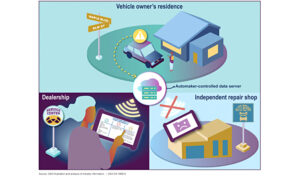The aftermarket is becoming more sensitive to economic changes and fluctuations in consumer income and purchase behavior
Fort Wayne, Ind.—Although replacement parts represent more than half of light vehicle product volume, their sales failed to keep pace with the overall light vehicle aftermarket between 2016 and 2021.
This has increased the difficulty of managing parts proliferation, changed the strength of the light vehicle distribution channels and reduced the recession-resistant nature of the aftermarket. Meanwhile, two of the three other major product groups (accessories, chemicals, and Tools & Equipment) topped the annual growth rate of replacement parts, according to this week’s Lang Aftermarket iReport.
The following is a breakdown and a few takeaways from the analysis.
Replacement Parts
Replacement parts (products necessary for vehicle operation and subject to wear and tear) accounted for nearly two-thirds of aftermarket product volume during 2016. However, replacement parts’ sales share fell to approximately 62% by 2021.
Despite their reduced product share, replacement parts recorded the largest increase in product volume during those five years.
Chemicals
All types of automotive chemicals, including those necessary for vehicle operation and discretionary chemicals (waxes, polishes, cleaners, etc.) also declined in light vehicle product share between 2016 and 2021.
Despite their share decline, however, chemicals recorded a sales increase and ranked second in overall car and light truck product volume during those five years.
Accessories
Accessories modify the appearance, performance or handling of light vehicles. They are not necessary for vehicle operation (such as replacement parts), since they modify vehicle performance rather than restore a vehicle to its original operating level.
Accessories boosted their light vehicle aftermarket product share the most of any product group.
During those five years, accessories ranked third in total aftermarket product volume and recorded the second-largest product gain.
Tools & Equipment
Tools & Equipment expanded their light vehicle product share by more than one-tenth between 2016 and 2021, the largest percentage gain of any product group. And the segment more than tripled the annual growth rate of replacement parts.
Aftermarket Growth Share
Despite their share decline, replacement parts generated more than half of light vehicle aftermarket product growth between 2016 and 2021, followed by accessories, which were responsible for nearly one-quarter of the more than $10 billion in aftermarket product growth at user-price.
Tools & Equipment ranked third in growth share at 12%, with chemicals responsible for 8% of light vehicle product expansion.
Product Growth Rates
Tools & Equipment achieved the highest annual product growth rate between 2016 and 2021, followed closely by accessories. In contrast, replacement parts and chemicals recorded annual growth rates lower than the average of all light vehicle aftermarket products.
Aftermarket Impact
Replacement parts’ diminishing share of aftermarket product sales has significant consequences, Lang reported.
• First, the falling product growth and share of replacement parts make it more difficult for aftermarket participants to manage parts proliferation since replacement parts represent the vast majority of aftermarket products and are necessary for vehicle operation. They are slipping in market share, but they must be readily available to keep cars and light trucks on the road.
• Second, the changing share of aftermarket volume of the four major product groups is shifting product volume among the five distribution channels supplying the light vehicle aftermarket.
• Third, as replacement parts recede in volume and share of aftermarket products, a growing portion of aftermarket sales is comprised of discretionary rather than non-discretionary purchases.
Consequently, the aftermarket is becoming more sensitive to economic changes and fluctuations in consumer income and purchase behavior, stated Lang. This makes the aftermarket less countercyclical to general economic conditions and less of a “recession-resistant” industry.



Comments are closed.